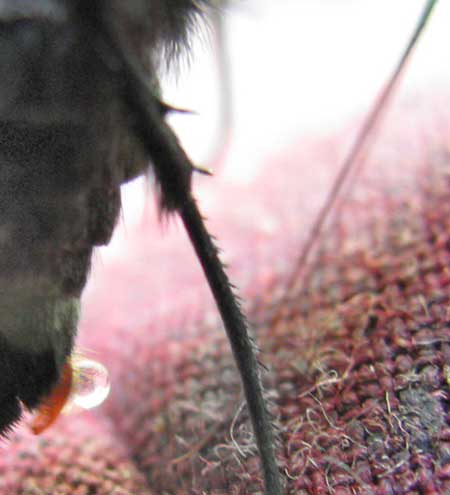Excerpts from Jim Conrad's
Naturalist Newsletter

from the August 1, 2010 Newsletter issued from Hacienda Chichen Resort beside Chichén Itzá Ruins, central Yucatán, MÉXICO; limestone bedrock, elevation ~39m (~128ft), ~N20.676°, ~W88.569°
SKIPPER AT A BANDANA SALT LICK
Bea had to struggle with the Zilpa Longtail, CHIOIDES ZILPA, shown on one of my bandanas above.
In the picture, notice that the skipper's long proboscis is angled in under its abdomen, that the abdomen is sort of arched forward, and that a tiny, pale globule seems to be emerging from the abdomen's tip. That globule is actually the first drop of an impressive squirt of liquid aimed at the patch of bandana upon which the proboscis's tip rests.
Because I'd twirled the bandana into a sweatband, it was full of dried sweat. The concept here is that the skipper's squirted fluid saturates a tiny part of the bandana, the sweat's salts and minerals dissolve in the fluid, and then with its proboscis the skipper sucks up the nutrients along with its own just-squirted, recycling fluid. You can see a close-up showing the beginning of another squirt of fluid just emerging from the abdomen's tip, the slender proboscis entering from the upper right, below:

It turns out that butterflies have a hard time managing their budgets of salts and minerals which, among other things, are necessary for making pheromones and sperm. When you see large numbers of butterflies around a puddle (aptly called "puddling") mainly sodium is being sought, that salt lacking in adult butterflies' diets, which is primarily nectar and fruits. Sodium is vital for digestion, excretion, reproduction and flight.
In fact, sodium is so precious that it, along with amino acids, is transferred to the female during mating as a "nuptial gift" that enhances the eggs' survival rate.
If you watch puddling butterflies you often see them squirting fluid from the ends of their abdomens -- sometimes the squirts shooting several body lengths from the butterfly! That's different from what's shown in the above photos. Squirting puddling butterflies are just getting rid of surplus water from which salts and minerals have been removed, a much simpler process than what's shown happening above.